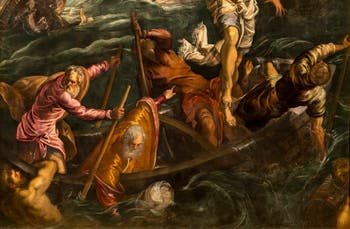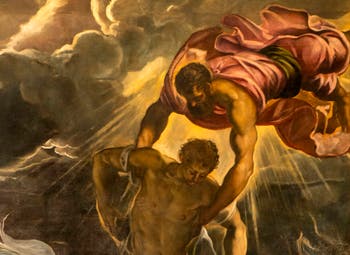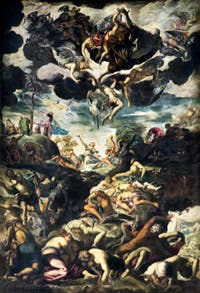Art Painters | Music | Literature | Video | Pictures
Painters Tintoretto | Titian | Canaletto | Fortuny | Albrecht Dürer |
Tintoretto Life and Career | Colors and Fame | Kings Churches Museums
Tintoretto and Free Creation
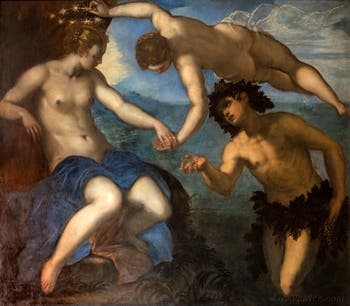
Arian, Venus and Bacchus
Jacopo Robusti... and free creation!
Vasari admitted the possibilities offered by the Venetian method of painting directly on canvas, as was the case with Titian, but he did not understand Tintoretto's approach.He considered Tintoretto to be capricious and single-minded, having gone beyond extravagance with his new and bizarre inventions, and who sometimes even passed off as finished works barely rough sketches in which we see brushstrokes thrown in fever, rather than with the logic of drawing.
In reality, this was neither carelessness nor extravagance, but the emergence of an artistic freedom that Tintoretto would clearly show in various forms, notably with the distant figures, veritable silhouettes metamorphosed into signs.
For example, the crowd gathered on the banks of the Jordan from the Baptism of Christ at the Scuola di San Rocco

Arian, Venus and Bacchus Yet we had sensed that, failing to represent the fullness of perfect Beauty, the liveliness of gesture, the tempo of Tintoretto's brushwork communicated the energy of his movement to his figures, and gave them the movement of life.
But it also communicated to them the uncertain, unpredictable, unstable, surprising and bewildering character of human actions unfolding in time.
Magical alliance of the touch beating the rhythm of creation.
It was the creation of this new, autonomous and changing unreal universe, born entirely of the magic of art that had surprised some of Tintoretto's contemporaries!
The Miracle of St. Mark Delivering the Slave inaugurated a series of paintings devoted to the life and legend of the Evangelist.
Tintoretto: The Translation of the Body of St. Mark
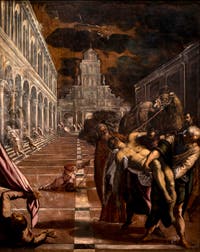
Translation of St. Mark The Discovery of the Body of St. Mark (now in Milan), The Translation of the Body of St. Mark and St. Mark Saving a Saracen from Shipwreck were commissioned in 1562 by Tomaso Rangone, for the Scuola di St. Mark.
“To the left of the altar the exhumation of St. Mark done stealthily; vigorously painted picture by Tintoretto.
Tintoretto's stealthy translation of the body of St. Mark: there is a singular effect of light in this painting.
The storm experienced by the vessel stealthily transporting the Saint's body: a very dark painting, the shadows having grown, but in which there are some beautiful colour effects”
Jérôme de Lalande - Travel to Italy
The translation of the body of St. Mark (3.98m x 3.15m)
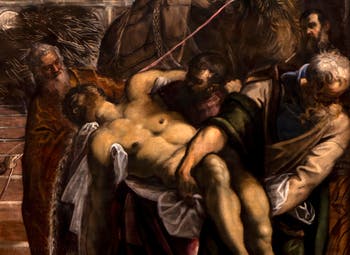
The Translation of the Body of St. Mark According to legend, a violent storm caused those who were preparing to burn the body of St. Mark the Evangelist after his martyrdom to flee.
The Christians of Alexandria took advantage of the situation to recover the body and bury it according to their rite.
Eight hundred years later, two Venetian merchants recovered it and transported it by boat to Venice, where it was to be laid to rest for good.
This painting by Tintoretto is an astonishing time-space shortcut:
St. Mark's athletic body bears neither the marks of time nor the traces of his martyrdom!
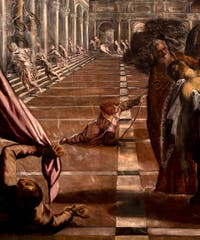
Translation of St. Mark Here, the Christians who take advantage of the storm to snatch him from the stake (extinguished by the providential storm?) are the two Venetian merchants, helped by Tomaso Rangone, who solicitously supports his head.
They flee Alexandria, followed by the camel, which escapes from its master.
They take St. Mark to Venice... where they have already arrived!
With their feet in the water, the paving and architecture are typically Venetian: those fleeing the storm run for refuge under the arcades of a building that bears a strong resemblance to the Procuraties; and the church at the back is the twin of San Geminiano.
The miracle is transposed to Venice, which welcomes the Evangelist in the Piazza to bury him in a splendid basilica. Both bear his name: Marco
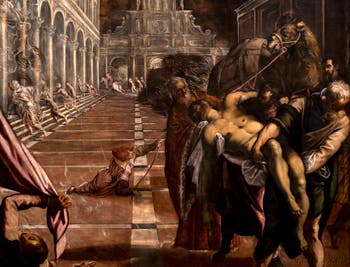
The Translation of the Body of St. Mark Saint Mark is now the sole patron saint of Venice, which here reaffirms its religious independence from Rome and the Vatican: the Basilica of Saint Peter in Rome, the basilica of Saint Mark in Venice. Mark the Evangelist is as good as the Apostle Peter!
This work by Tintoretto is right in line with the policy of independence advocated by the “modern” which would be championed by the famous friar Paolo Sarpi
The Scuola di San Marco having become a hospital, these works are currently housed at the Accademia
The Aretine and Tintoretto

St Mark saves a Sarasin
The Meeting between the Aretin and Tintoretto
“An insulting sonnet was being circulated in Venice for the little dyer, who immediately resolved to impose silence on the venomous tongues.
One day when he spotted the Aretinus in the vicinity of St. Mark's Square, Jacopo approached him politely and asked him to come and have a look at his works and give him an hour's sitting, saying that he wanted to do a pencil portrait of such a famous figure.
L'Arétin, carried away by such courtesy, and thinking that the young painter was unaware of the sonnet, let himself be taken to San-Luca.
As soon as he entered the studio, he saw his host carefully close the door, run over to a trophy of arms, take out a very sharp dagger, and step forward with the weapon in his fist.
St Mark saves a Sarasin Jacques Robusti lived up to his name: his square shoulders, high waist, wiry arms, energetic countenance and the thick forest of hair that stood on his broad head gave him the appearance of a sturdy athlete and a bad encounter for a man who had offended him.
The Aretin repented his imprudence too late.
- Lord Robusti," he cried, changing his face, "what do you want to do with this dagger?
- Stand up straight and don't move," Tintoretto told him brusquely, "otherwise I'll answer for nothing.
The Aretin, trembling with all his limbs, saw Jacopo come up to him and look him over from head to foot with the dagger.
St Mark saves a Sarasin - You have," continued the painter, "two and a half times the length of this blade. Wasn't it necessary, in order to paint an accurate portrait of you, for me to have the measure of your person?
That's the end of it; but don't forget that, if you happen to insult me in your sonnets, I will use this dagger to measure your heart and entrails.
Now, sit down in this armchair, and let us talk together without getting angry, while I put your lordship's frightened face on this paper.
From that moment the Aretin never uttered the name of the Tintoretto, and refrained from blame as well as praise.
But the coterie of Titian and his friends always remained hostile to Jacques Robusti; that is why he had the advantage over his rival, if not in talent, at least in character.
Tintoretto never ceased to profess equal admiration for Titian and Michelangelo, as evidenced by the two names inscribed in his studio, reminding young people of the two great models that, in his opinion, every ambitious painter should propose to himself.
St Mark saves a Sarasin This homage and justice did not appease his enemies; and when Sansovino completed the beautiful bronze doors of the sacristy of St. Mark's, he placed there, among his graceful figures, the heads of the Aretinus and the Titian next to his own, and forgot that of Tintoretto, whose proximity would certainly not have harmed the other three.
On the contrary, Jacques Robusti, in his compositions, took pleasure, with a generous obstinacy, in often reproducing the figure of the great master, whose rancour he was never able to soften.”
Paul de Musset - Voyage en Italie
Tintoretto actually painted a portrait of the Aretin in 1551.
Tintoretto and the Scuola Grande di San Rocco
On 31 May 1564, the Scuola Grande di San Rocco opened a sketching competition to choose the work to decorate the ceiling of its Albergo. The entrants included Schiavone, Veronese, Salviati, Zuccari and Tintoretto.
Saint Roch in Glory After enquiring about the exact dimensions of the location, by 22 June Tintoretto had completed his Saint Roch in Glory, and managed to have it installed directly on the ceiling of the Sala dell'Albergo... when the other competitors had barely finished their sketches!
And, when the Brotherhood of Rocco pointed out that they hadn't asked for a finished painting but for a sketch, Tintoretto is said to have replied “that this was his way of drawing, that he didn't know any other way, and that sketches and works had to be like this so as not to mislead anyone; and that finally, if they didn't want to pay him for his work and his efforts, he would make them a gift of it. ” (According to Vasari)
According to the Scuola rules, a gift offered as a sign of devotion to the Saint could not be refused.
Saint Roch in Glory remained in place, and Tintoretto completed the rest of the ceiling decoration free of charge, along with around twenty other canvases.
Then, having become a member of the Brotherhood of Rocco, in 1565 he painted the huge Crucifixion that occupies the entire wall opposite the entrance to the Albergo, where The Titian had proposed placing one of his paintings in 1553.
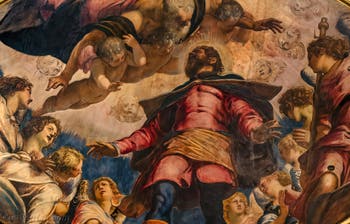
Saint Roch in GlorySuch was the success of this painting, that he was entrusted with the rest of the decoration of the Albergo with works illustrating the passion of Christ.
By 1567, he had fulfilled his contract with Christ before Pilate, Ecce Homo and The Ascent to Calvary.
In 1575, when the Scuola decided to renovate the decoration of the great Chapter Room with teleri (large-format canvases) he offered to paint free of charge the canvas that would occupy the centre of the ceiling: The Miracle of the Bronze Serpent.
He then offered to paint the other two large canvases on the ceiling, in exchange for a simple refund of the cost of materials.
So much so, that he ended up being commissioned to decorate the Scuola and the church of San Rocco against simple reimbursement of the material, to which was added an annual annuity of one hundred ducats. He worked there until 1588.
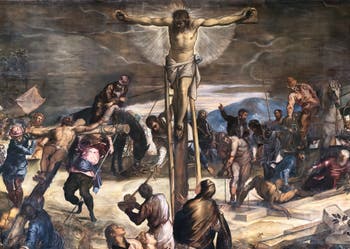
Crucifixon In twenty-four years, Tintoretto had covered the walls and ceilings of the Scuola di San Rocco with around fifty paintings.
That's what we call dedication, considering that the usual price of just one of these large paintings, which can be admired today at the Scuola di San Rocco, was precisely... a hundred ducats!
One can imagine all sorts of reasons or explanations for such dedication: love of art, a desire for glory, a desire to make a name for himself at all costs, mad generosity or a need to fill every possible space with his painting, correlating with a creative fury.
But the fact remains that Jacopo Robusti did not use his art to make a fortune.
“Tintoretto painted part of the life of Jesus Christ at the Saint-Roch school, in a quantity of large paintings.
The Bronze Serpent Another painter's life would not have been enough to do all that he has, executed here, and almost always very well.
It is here that any painter will find an inexhaustible school of drawings and chiaroscuro: the Annunciation, the Flight into Egypt, the Last Supper, and especially the figure of Jesus Christ, dressed in white before Pilate, and the great painting of the Crucifixion, Tintoretto's masterpiece, of which Augustine Carrache engraved such a beautiful print, seemed to me to be admirable.
What a pity that this painter, with so much talent, has not at all known the graces which alone can give them price!”
Charles De Brosses - Familiar letters 1739-1740
“At the Scuola San Rocco, the Probatic Pool, a marvellous work by Tintoretto.
There he showed that he knew perfectly well, when he wanted to take the trouble, how to order without fury, draw without harshness and colour without blackness.
I would be strongly inclined to judge that Tintoretto is the first of all Venetian painters, when he wants to do well, which very rarely happens to him.”
Charles De Brosses - Familiar letters 1739-1740
Tintoretto Life and Career | Colors and Fame | Kings Churches Museums
Painters Tintoretto | Titian | Canaletto | Fortuny | Albrecht Dürer |
Art Painters | Music | Literature | Video | Pictures
Back to Top of Page


